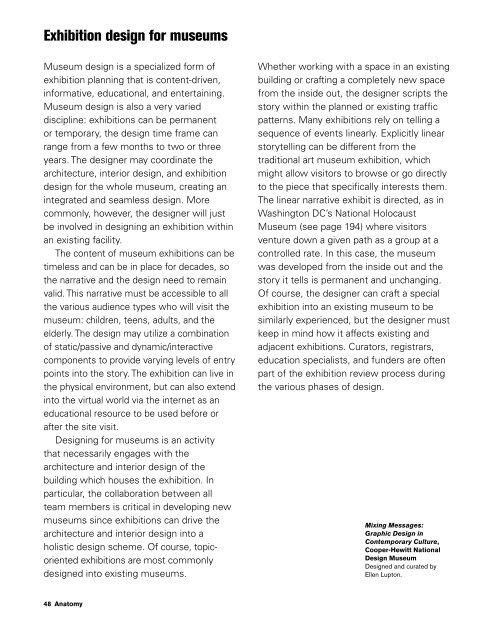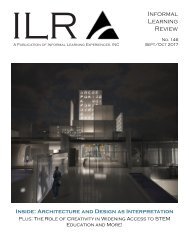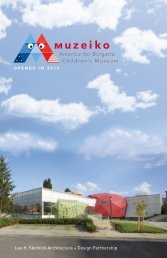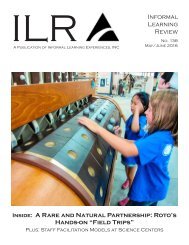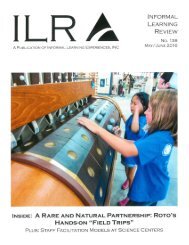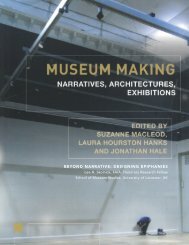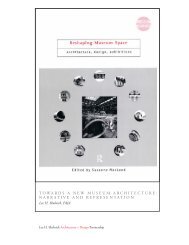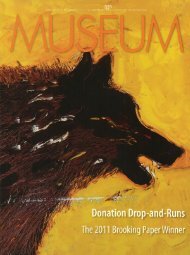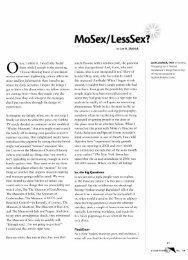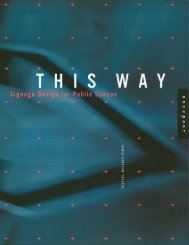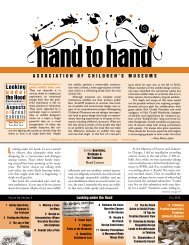070821 LHS_WIED.PDF
- No tags were found...
Create successful ePaper yourself
Turn your PDF publications into a flip-book with our unique Google optimized e-Paper software.
Exhibition design for museums<br />
Museum design is a specialized form of<br />
exhibition planning that is content-driven,<br />
informative, educational, and entertaining.<br />
Museum design is also a very varied<br />
discipline: exhibitions can be permanent<br />
or temporary, the design time frame can<br />
range from a few months to two or three<br />
years. The designer may coordinate the<br />
architecture, interior design, and exhibition<br />
design for the whole museum, creating an<br />
integrated and seamless design. More<br />
commonly, however, the designer will just<br />
be involved in designing an exhibition within<br />
an existing facility.<br />
The content of museum exhibitions can be<br />
timeless and can be in place for decades, so<br />
the narrative and the design need to remain<br />
valid. This narrative must be accessible to all<br />
the various audience types who will visit the<br />
museum: children, teens, adults, and the<br />
elderly. The design may utilize a combination<br />
of static/passive and dynamic/interactive<br />
components to provide varying levels of entry<br />
points into the story. The exhibition can live in<br />
the physical environment, but can also extend<br />
into the virtual world via the internet as an<br />
educational resource to be used before or<br />
after the site visit.<br />
Designing for museums is an activity<br />
that necessarily engages with the<br />
architecture and interior design of the<br />
building which houses the exhibition. In<br />
particular, the collaboration between all<br />
team members is critical in developing new<br />
museums since exhibitions can drive the<br />
architecture and interior design into a<br />
holistic design scheme. Of course, topicoriented<br />
exhibitions are most commonly<br />
designed into existing museums.<br />
Whether working with a space in an existing<br />
building or crafting a completely new space<br />
from the inside out, the designer scripts the<br />
story within the planned or existing traffic<br />
patterns. Many exhibitions rely on telling a<br />
sequence of events linearly. Explicitly linear<br />
storytelling can be different from the<br />
traditional art museum exhibition, which<br />
might allow visitors to browse or go directly<br />
to the piece that specifically interests them.<br />
The linear narrative exhibit is directed, as in<br />
Washington DC’s National Holocaust<br />
Museum (see page 194) where visitors<br />
venture down a given path as a group at a<br />
controlled rate. In this case, the museum<br />
was developed from the inside out and the<br />
story it tells is permanent and unchanging.<br />
Of course, the designer can craft a special<br />
exhibition into an existing museum to be<br />
similarly experienced, but the designer must<br />
keep in mind how it affects existing and<br />
adjacent exhibitions. Curators, registrars,<br />
education specialists, and funders are often<br />
part of the exhibition review process during<br />
the various phases of design.<br />
Mixing Messages:<br />
Graphic Design in<br />
Contemporary Culture,<br />
Cooper-Hewitt National<br />
Design Museum<br />
Designed and curated by<br />
Ellen Lupton.<br />
48 Anatomy Exhibition design for museums 49


